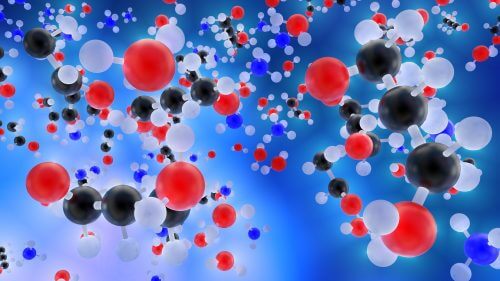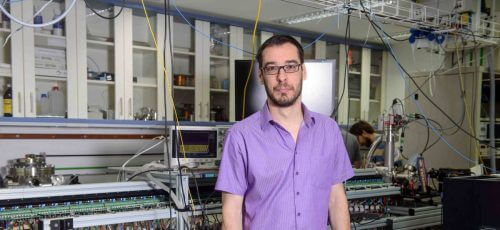What is the chemical reaction created by a meeting between molecules, at a temperature close to absolute zero? Scientists from the Weizmann Institute discovered that at very low temperatures, collisions between molecules can cause them to move either as spheres or as elongated bodies.

The movement of a body following a collision with another body largely depends on its shape: a spherical body will rotate in a different way than an elongated body. Molecules, of course, are not spherical, but at very low temperatures - close to absolute zero - it is possible to make them move either as spheres or as elongated bodies following a collision. This conclusion emerges from a recent study Prof. Edwards Narevičius and his research group, in the Department of Physical Chemistry at the Weizmann Institute of Science. These findings, which were recently published in the scientific journal Nature physics, confirm a hypothesis in the field of quantum theory, and they may influence the construction of experimental setups in chemistry and physics.
Collisions between atoms and molecules occur all around us all the time, and are essential to most chemical reactions. But to understand this process in depth, quite a few scientists turn to the world of quantum phenomena. Prof. Narevičius and his research group created a unique experimental set-up, which enables the study of chemical reactions between atoms or between molecules at a temperature close to absolute zero - by causing collisions between them by merging two parallel particle beams.
In the current experiment, the scientists focused on the collisions that occur between the molecules. Collisions of atoms have been studied in the past, but atoms - according to classical physics - are spherical, while molecules have an elongated structure. As mentioned, the structure of a colliding body affects the way it will move after the collision. For example, a hydrogen molecule (H2), the simplest molecule, consists of two atoms bonded together. Will the elongated hydrogen molecules behave differently from spherical atoms? And is knowing their shape enough to predict the outcome of the collision?
According to classical physics, bodies at rest can be described by their formal structure. But according to quantum theory, atoms, molecules and electrons are in constant motion even at very low energies, close to absolute zero. Therefore, the result of a collision between molecules depends not only on their formal structure, but also on their directionality, which according to quantum theory is not well defined, but appears in a sort of collection of possibilities. To understand the "shape" of the molecule, the distribution of these possibilities must be analyzed. Trying to understand the interrelationships between different factors in the quantum world poses additional challenges: according to quantum theory, it is impossible to directly follow the collision between an atom and a molecule (as it is possible, for example, in the "world of large objects", to watch the movement of billiard balls on a table) .

"Fortunately," says Prof. Narevičius, "we have an excellent tool that helps us observe such occurrences. In a previous study we discovered a narrow range of very low temperatures, where the rate of reactions is significantly higher than the normal rate. In this field, instead of particles being released back from the molecule they collided with, a phenomenon called 'tunneling' occurs, and the molecules pass through the energy barrier, which increases the probability of the reaction occurring."
The members of Prof. Narevičius' research group, including research students Ayelet Klein and Yuval, who, together with theorists Dr. Wojciech Skomorowski and Prof. Christian Koch from the University of Kassel in Germany, performed two collision experiments and analyzed the results. In the first experiment, the molecules were in the ground state, that is, their rotational energy was the minimum possible, and in the second experiment, the molecules were in an "excited" state. In both experiments, the collision data between the hydrogen molecules and the helium atoms was measured.
The researchers, who were looking for changes in the reaction rate of the colliding particles that would indicate the existence of tunneling, performed the two experiments in a series of temperatures - from room temperature to a temperature of a few millikelvins, i.e. several thousandths of a degree above absolute zero. Throughout most of the range, up to one degree Kelvin, most molecules behaved as spheres. "It was impossible to distinguish between them and atoms," says Prof. Narevičius. "But when the reaction entered the millikelvin range, interesting things started to happen. Molecules in the rotational energy ground state continued to behave as spherical bodies; In contrast, molecules in an excited state behaved like sticks during a collision. Simple molecules, in their ground state, are perfectly symmetrical, like atoms. Exciting them causes the symmetry to be broken, revealing their true elongated shape. By controlling the excitation state of the molecule, it is possible to create a kind of transfer switch between the behavior of an atom and the behavior of a molecule."
Now the scientists plan to expand the experiment from single collisions to an array that includes many bodies. Experiments in which many molecules create a sort of "condensed" state are expected to expand the insights in this field, and perhaps even lead to the possibility of controlling the mutual relations between molecules by changing their state of excitation and vorticity.
#Science_Numbers
At a temperature lower than 1 degree Kelvin, the structure of a hydrogen molecule that collides with an atom changes. Instead of a symmetrical structure, it "adopts" a perfect spherical structure.
